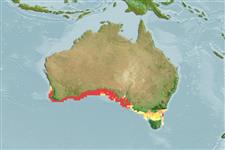>
Acropomatiformes (Oceanic basses) >
Pentacerotidae (Armorheads) > Histiopterinae
Etymology: Parazanclistius: Greek, para in the side of + Greek, za = an aumentative particle + Greek, agklino = to bo on one´s back (Ref. 45335).
Eponymy: Dr J Barry Hutchins (d: 1946) was Curator of Fishes at the Western Australian Museum (1998–2007), which he joined as a Technical Officer (1972) and where he worked until he retired. [...] (Ref. 128868), visit book page.
Environment: milieu / climate zone / depth range / distribution range
Écologie
marin démersal; profondeur 10 - 80 m (Ref. 9563). Subtropical
Eastern Indian Ocean: southern Western Australia. Has previously been confused with Zanclistius elevatus.
Taille / Poids / Âge
Maturity: Lm ? range ? - ? cm
Max length : 34.0 cm TL mâle / non sexé; (Ref. 9563)
Occurs on the continental shelf (Ref. 9563).
Life cycle and mating behavior
Maturité | Reproduction | Frai | Œufs | Fécondité | Larves
May, J.L. and J.G.H. Maxwell, 1986. Trawl fish from temperate waters of Australia. CSIRO Division of Fisheries Research, Tasmania. 492 p. (Ref. 9563)
Statut dans la liste rouge de l'IUCN (Ref. 130435: Version 2024-2)
Menace pour l'homme
Harmless
Utilisations par l'homme
Outils
Articles particuliers
Télécharger en XML
Sources Internet
Estimates based on models
Preferred temperature (Ref.
123201): 16 - 19.3, mean 17.4 °C (based on 96 cells).
Phylogenetic diversity index (Ref.
82804): PD
50 = 1.0001 [Uniqueness, from 0.5 = low to 2.0 = high].
Bayesian length-weight: a=0.01995 (0.00906 - 0.04395), b=3.01 (2.83 - 3.19), in cm total length, based on all LWR estimates for this body shape (Ref.
93245).
Niveau trophique (Ref.
69278): 3.3 ±0.4 se; based on size and trophs of closest relatives
Résilience (Ref.
120179): Faible, temps minimum de doublement de population : 4,5 à 14 années (Preliminary K or Fecundity.).
Fishing Vulnerability (Ref.
59153): High vulnerability (64 of 100).
